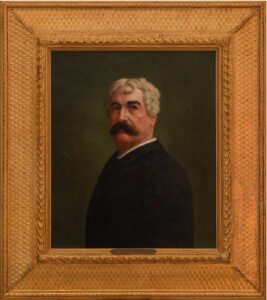 John Lester Wallack (born John Johnstone Wallack) was an American actor and son of James William Wallack. He joined The Lambs in 1875, which frequently met at Wallack’s Theatre. He served as Shepherd for three terms: 1878-1879, 1880-1882, and 1884-1888. Wallack was one of the founders of The Actors’ Fund of America and served as its first president, 1882-1883.
John Lester Wallack (born John Johnstone Wallack) was an American actor and son of James William Wallack. He joined The Lambs in 1875, which frequently met at Wallack’s Theatre. He served as Shepherd for three terms: 1878-1879, 1880-1882, and 1884-1888. Wallack was one of the founders of The Actors’ Fund of America and served as its first president, 1882-1883.
Wallack was born Dec. 31, 1819, in New York but at an early age he was taken to his parents’ home in London where he was reared and educated. He had chosen a military career but became discouraged and went to Dublin where he went upon the stage. He remained for two seasons and then went to Edinburgh. Then in 1846, he appeared in London at the Haymarket Theatre under Benjamin Webster’s management. There he was seen by an American manager’s agent who had come over to London to engage actors for the Broadway Theatre in New York. By him he was engaged and brought back to America in 1847.
In the theatrical world he was known primarily as Lester Wallack. When he made his first stage appearance in New York in 1847 it was under the name of John Lester when he appeared as Sir Charles Coldstream, in Dion Boucicault’s adaptation of Used Up. His father’s brother, Henry Wallack, the father of James William Wallack, Jr., was also in the Broadway Theatre’s company. His second appearance was as Viscount de Ligny in Captain of the Guard by James Planché. Subsequently, he performed at the Bowery Theatre, Burton’s Theatre, Niblo’s Garden, and Brougham’s Lyceum. His first appearance at the Bowery Theatre was in 1849 as Don Caesar de Bazan. Wallack’s greatest successes were in light comedy and romantic parts.
He was a manager of the second Wallack’s Theatre beginning in 1861 (demolished in 1901), and in 1882 he opened the third at 30th Street and Broadway (demolished in 1915). Another Wallack’s Theatre at 254 West 42nd Street in New York was named for him in 1924.
His wife was Emily Mary Millais. Wallack had three sons, among them: Arthur J. Wallack (1849-1940) was one of the six founders of The Lambs at the December 1874 dinner at Delmonico’s, and Harold B. Wallack (1854-1906) who was elected as a charter member in 1877. Wallack’s autobiography is titled Memories of Fifty Years.
Wallack had a family summer residence in Long Branch, New Jersey, that drew many actors and actresses to the Jersey Shore. He had a large estate in Stamford, Connecticut, that today is still known as Wallack’s Point. Wallacks Road is named for him.
In June 1888 the “washing” of The Lambs appeared in the New York Times, because it was such a festive occasion. A clambake was held at Wallack’s island house in Connecticut, and the Lambs took a private steamboat from the city to get there. According to the newspaper:
“The annual “washing” of the Lambs of the Lambs Club was held last Sunday at Wallack’s Island, the property of Lester Wallack, adjoining his home at Stamford. The members of the club left the city Sunday morning by the steamer Shady Side for Stamford, and from there went to the island by a smaller steamer. The chief feature of the day was a monster “clambake” gotten up Captain Babcock, the great clambake promoter and manufacturer, with a washing of champagne. After the feast the Lambs retired to a field on the Wallack property and engaged in a grand game of baseball. DeWolf Hopper was captain of one side and Digby Bell of the other. Bell distinguished himself by his ability to bunt the ball, but as a sprinter he was a dismal failure. Hopper got to first base and no ball could be thrown so high that he could not reach it, and when running the bases he merely stretched his mighty legs and stepped from one base to another… A pleasant feature of the day was the presentation to Colonel John A. McCaull by Harold Wallack of a magnificently bred and marked Laverack Setter, one of the handsomest dogs in America.”
John Lester Wallack died just three months later, on September 6, 1888, in Stamford. He was 68 years old. Wallack is interred in Green-Wood Cemetery in Brooklyn. His grave is next to the first shepherd of The Lambs, Henry J. Montague. They have matching graves.
—Kevin C. Fitzpatrick, Club Historian, with information from Lewis J. Hardee, past historian